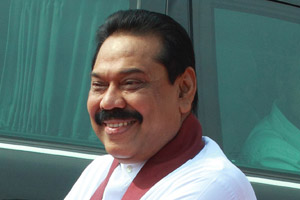Ilankai Tamil Sangam28th Year on the Web Association of Tamils of Sri Lanka in the USA |
|||
 Home Home Archives Archives |
Sri Lanka Without the Chaosby Sudeep Chakravarti, LiveMint.com & The Wall Street Journal, June 7, 2012
In his vision document, Rajapaksa had added: “I will also not permit anyone to destroy democracy in our country.” This is now coming unstuck, with the Rajapaksa conglomerate seen as undermining the spirit of democracy In 2005, when he became president of Sri Lanka, Mahinda Rajapaksa issued a document titled Mahinda Chintana, or Mahinda’s Vision. In it he proclaimed: “I will not permit any separatism.” This he held true to, corralling a brutal rebellion by the Liberation Tigers of Tamil Eelam (LTTE). The nearly 30-year war ended in May 2009 after the decimation of the LTTE and the death of its chief, Velupillai Prabhakaran. (The killing of its protégé-turned-pest stabilized India’s warped policy towards this neighbour. Indian support to Sri Lanka’s government and military for the final push against the LTTE also shored up India’s geopolitical and economic ambitions in this island nation.)
On the face of it, the signs are better. In 2009, I heard economists in Colombo say that just stopping the war would spur economic growth by two percentage points a year—and more by a sort of Marshall Plan in the war-stunted north and east of the country that have large indigenous Tamil populations. From 3.5% in 2009, the economy grew 8% a year for two straight years. As I visited this past week, forecasts called a still robust 7% growth for 2012. Colombo is today a brash capital in the middle of a construction and regeneration boom. The Chinese-aided deep water port in Hambantota, a major hub to the south, is a reality. Hambantota’s new international airport is expected to open to overseas flights later this year. I heard young businessmen discussing deals in yuppie watering holes in Colombo and saw investors making forays along the vast beachfront in Trincomalee, where luxury properties have already made their mark. Indian businesses invested an estimated $150 million in this country last year, in areas ranging from education and information technology to real estate. The price is the stranglehold the Rajapaksas have on the country. Any dissent is punished, as Sarath Fonseka, army chief and war hero—and once Rajapaksa’s favourite—discovered when he contested against Rajapaksa in the presidential elections in 2010, and was jailed on charges of anti-state activities. (The popular ex-general was released by presidential pardon in late May on the back of growing international pressure. Parliament is also in the control of the Rajapaksa-led United People’s Freedom Alliance.) Critics of the regime continue to be intimidated, and some still “disappear”, reliving the time of the final war years. Rajapaksa’s image and attitude are everywhere on billboards. He is even on the money. New LKR 1,000 notes have Rajapaksa’s likeness on it, replacing the caparisoned elephants on older notes of that denomination. On the reverse of the “MR” notes is a copy of the iconic World War II image of American soldiers planting their flag on the island of Iwo Jima. Here Sri Lanka’s armed forces are shown in a similar pose. They replace the peacock. Rajapaksa’s strutting may not be his country’s undoing as much as the continuing absence of power-sharing with Tamils in the country’s north and east, a long-denied equality in letter and spirit for the country’s main ethnic minority that lies at the root of Tamil angst and sparked the rebellion that the LTTE hijacked and ruthlessly nurtured. The country’s Eastern Province, with the key seafront hubs of Batticaloa and Trincomalee, has for long been part of an ongoing “Sinhalization”, to quote the International Crisis Group (ICG). A March 2012 ICG report mentions a similar imprint on the Northern Province, with Jaffna as its capital. It includes resettling ethnic Sinhalese in Tamil-majority areas, riding a growing militarization of the northern and eastern regions—with the army reportedly deciding reconstruction priorities. On top of this, there are tens of thousands of internally displaced people; and an estimated 40,000 civilian deaths, nearly all Tamil, that Sri Lanka’s government flatly denies it inflicted to score a victory during the war’s final surge. Fear and unease in these parts are evident even in casual conversations. A combination of these factors could trigger a resurgence of Tamil anger. It’s for Rajapaksa to work a productive, benevolent Sri Lanka. Or invite chaos to revisit. ------------------------------------------------------------ Sudeep Chakravarti writes on issues of conflict in South Asia. He is the author of Red Sun: Travels in Naxalite Country and the just-published Highway 39: Journeys through a Fractured Land. This column, which focuses on conflict situations that directly affect business, runs on Fridays.
| ||
 In his vision document, Rajapaksa had added: “I will also not permit anyone to destroy democracy in our country.” This is now coming unstuck, with the Rajapaksa conglomerate seen as undermining the spirit of democracy. Besides Rajapaksa, it includes brother and long-time adviser and economic development minister Basil Rajapaksa; another brother, the powerful defence secretary Gotabhaya Rajapaksa; and their extended families. They run Sri Lanka. The concern is whether they may run it to the ground.
In his vision document, Rajapaksa had added: “I will also not permit anyone to destroy democracy in our country.” This is now coming unstuck, with the Rajapaksa conglomerate seen as undermining the spirit of democracy. Besides Rajapaksa, it includes brother and long-time adviser and economic development minister Basil Rajapaksa; another brother, the powerful defence secretary Gotabhaya Rajapaksa; and their extended families. They run Sri Lanka. The concern is whether they may run it to the ground.